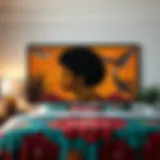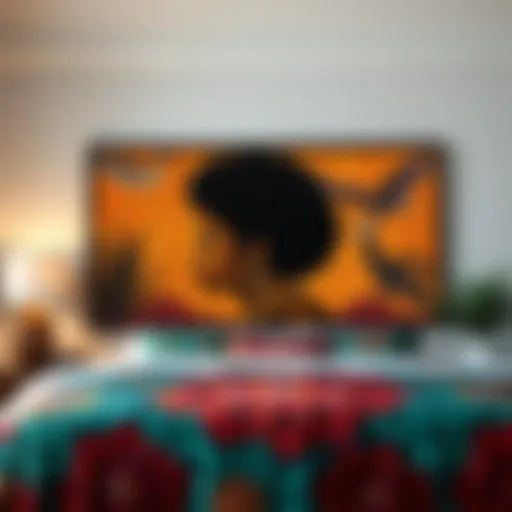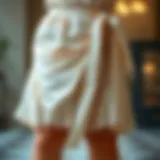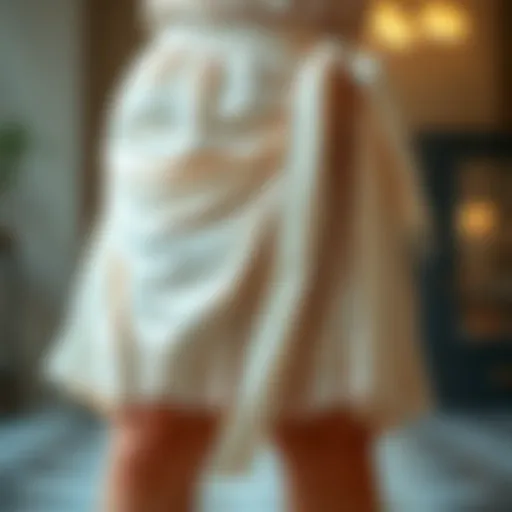The Art of Plexiglass Decoration: Transforming Spaces
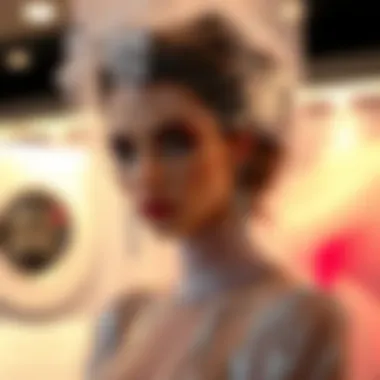

Intro
Plexiglass has emerged as an exceptional medium in the realm of decoration, offering an impressive blend of functionality and artistry. Historically overshadowed by traditional materials like wood and metal, plexiglass is now stepping into the spotlight, bringing with it a sense of modernity that is hard to ignore. Its versatility makes it suitable for a wide array of applications, from sleek tables to stunning light fixtures. This article will navigate through the nuances of plexiglass decoration, guiding readers on how to infuse elegance into spaces while considering contemporary design principles and sustainability.
Fashion Trends
Current Seasonal Trends
In the world of interior design, trends evolve as dynamically as they do in fashion. Currently, we observe a sweeping trend towards minimalism, with designers favoring clean lines and transparency that plexiglass facilitates. Think subtle shades or clear finishes that blend beautifully with natural light. The past year has seen an uptick in the popularity of statement pieces—a bold plexiglass sculpture or a coffee table with unique shapes can tie a room together, serving as both a conversation starter and a visual anchor.
"Simplicity is the ultimate sophistication."
– Leonardo da Vinci
Influential Design Icons
Several designers are pushing the plexiglass envelope, showcasing its adaptability and elegance in luxurious settings. For instance, Philippe Starck, with his imaginative vision, has created stunning plexiglass furniture that exudes chic sophistication. Meanwhile, Zaha Hadid’s Architectural approach has utilized the material to convey fluidity in forms, blurring the lines between art and functional design.
Benefits of Plexiglass Decor
Plexiglass boasts many advantages that cater to the modern designer's ethos:
- Durability: Unlike glass, plexiglass is shatter-resistant, making it safer for spaces frequented by children or pets.
- Weight: The lightweight nature makes handling and installation a breeze without sacrificing visual impact.
- Versatile Aesthetics: Available in a multitude of colors and textures, it can adapt to any design scheme.
Even more, its sustainability factor is worth noting. Many plexiglass products are recyclable, aligning with the growing demand for eco-friendly materials in the design industry.
Practical Tips for Incorporating Plexiglass
Incorporating plexiglass into your spaces need not be daunting. Here are a few practical tips to ease the transition:
- Start Small: If you're anxious about overwhelming a room, begin with smaller items like picture frames or display cases. They can refresh your decor without major commitment.
- Mix Textures: Plexiglass pairs beautifully with softer materials. Consider matching it with wood or fabric to create a balanced aesthetic.
- Emphasize Lighting: Use plexiglass light fixtures or accents to scatter light across a room, promoting a bright and airy feel.
- Go Big or Go Home: If you feel adventurous, large plexiglass pieces can serve as striking focal points. Think of room dividers or oversized art pieces that lend a modern edge.
For more on contemporary design and decor techniques, visit resources like Britannica for insights or Wikipedia for general knowledge on materials like plexiglass.
Preface to Plexiglass Decoration
Plexiglass decoration stands as a remarkable intersection of art and functionality, offering a fresh approach to interior and exterior design. Amidst the ever-evolving trends in the world of design, plexiglass emerges as a material that effortlessly balances style with utility. Its clarity, versatility, and contemporary aesthetic appeal not only enhance spaces but also challenges the norms of traditional decoration.
The significance of plexiglass in modern decor cannot be overstated. In both residential and commercial environments, this material plays a crucial role in redefining spaces. Its ability to reflect light while maintaining an impression of openness is perhaps its most celebrated feature. When integrated thoughtfully, plexiglass can create a sense of elegance that is both understated and impactful. Think about it—without the weightiness of traditional materials, spaces feel more spacious and inviting.
There are a few key elements to contemplate when diving into plexiglass decoration:
- Transparency: One of plexiglass’s key advantages is its clarity, making rooms feel larger and brighter. This transparency allows it to blend seamlessly with various design styles, from modern minimalism to more eclectic themes.
- Color Variety: Although often found in clear forms, plexiglass comes in various colors and finishes, including frosted and mirrored options. These variations add depth and character to designs, offering more than just reflection.
- Durability: Unlike glass, plexiglass is shatter-resistant. This property not only enhances safety but also means less maintenance in busy environments, making it an ideal choice for both homes and commercial spaces.
When one considers the implications of integrating plexiglass, a few considerations arise. The careful balance between aesthetics and function is paramount. Homeowners and designers alike should contemplate aspects like light play, temperature changes that can affect pliability, and even potential scratches. Thus, understanding how to care for and maintain plexiglass decorations elevates the overall experience.
"Design is not just what it looks like and feels like. Design is how it works."
– Steve Jobs
In exploring the art of plexiglass decoration, it becomes clear that this material transcends mere utility. It serves as a canvas for creativity, allowing designers to push the envelope of traditional decor. Therefore, studying its various applications, characteristics, and integration into existing designs paves the way for a deeper appreciation of its transformative power. Through careful consideration of its advantages and potential challenges, one can unlock new dimensions in decorative design, making spaces not just livable, but truly vibrant.
Understanding Plexiglass
Understanding plexiglass is foundational when it comes to exploring its applications in decoration. This topic not only frames the context of how this material can be transformed into decorative pieces, but it also brings to light the unique properties that make plexiglass so appealing. Being in the design and décor realm, grasping plexiglass’s characteristics and distinguishing it from other materials can elevate any project from mediocre to remarkable.
What is Plexiglass?
Plexiglass, known scientifically as polymethyl methacrylate (PMMA), is a transparent thermoplastic often used as a lightweight or shatter-resistant alternative to glass. You can think of it as glass’s more versatile cousin, offering both clarity and flexibility. Originally developed in the mid-20th century, this material gained popularity due to its aesthetic appeal and practical applications. Its transparent nature allows for light to filter through, giving spaces a sense of openness while retaining structural strength. This versatile polymer can be molded and shaped, making it suitable for a variety of decorative needs, from creative signage to furniture pieces. The transition from raw material to a stunning final product is what makes plexiglass so fascinating.
Characteristics of Plexiglass
Plexiglass possesses several noteworthy characteristics:
- Transparency: One of its standout features, allowing it to reflect light beautifully and create an illusion of space.
- Durability: It’s resistant to impact, cracking, or shattering, setting it apart from traditional glass.
- Lightweight: Plexiglass is significantly lighter than glass, making it easier to handle during installation and updating decor.
- Weather Resistance: Unlike some materials that fade or deteriorate when exposed to the elements, plexiglass retains its clarity for years.
- Versatility: This can be customized in colors and textures, allowing designers to tailor it to specific aesthetic needs.
These characteristics don't just make plexiglass a practical choice; they also offer a playground for creativity in design. The unique combination of form and function makes it an excellent option for various decorative purposes.
Comparison with Other Materials
When considering plexiglass, it’s essential to compare it to similar materials such as glass, acrylic, and polycarbonate. Each has its own set of advantages and disadvantages, impacting its usability in decoration.
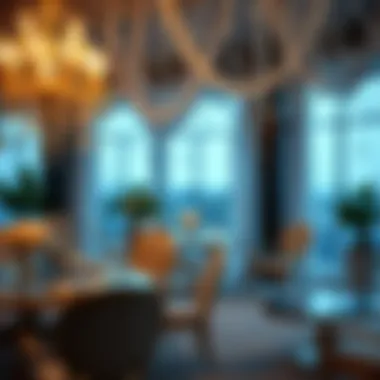

- Glass: While glass is aesthetically pleasing, it can be brittle and heavy, presenting certain challenges during installation or shipment. Also, it’s more prone to breaking, resulting in higher maintenance.
- Acrylic: Often confused with plexiglass, acrylic is actually a type of plastic that usually shares many similarities with PMMA. Plexiglass tends to be of higher clarity and is less prone to yellowing over time compared to standard acrylic options.
- Polycarbonate: This material is even more durable than plexiglass and can withstand extreme conditions. However, it’s often less clear and can scratch more easily, which might not align with all design goals.
Incorporating insights on these materials helps delineate the role of plexiglass in decoration. It solidifies its status as a superior candidate for designers looking for both elegance and substance in their work.
"Understanding the materials you work with is just as crucial as the design itself. Plexiglass exemplifies how careful material selection can lead to the desired ambiance in any space."
In summary, understanding plexiglass is essential for anyone keen on utilizing it in decoration. Its unique properties, versatility, and aesthetic appeal make it a valuable asset in creating beautiful, functional spaces. Designers should leverage their knowledge of this material to craft pieces that resonate with modern sensibilities.
Applications of Plexiglass in Decoration
Plexiglass, often termed as acrylic glass, represents a versatile material that serves as a cornerstone of modern decoration. Its wide-ranging applications in both residential and commercial settings make it an invaluable choice for designers and homeowners alike. Not only does it contribute to aesthetics, but it also provides functionality that few materials can match. In this section, we'll dig deeper into how plexiglass transforms interiors and exteriors, enhancing spaces while providing practical benefits.
Residential Interiors
Furniture
When it comes to furniture, plexiglass is more than just a pretty face. Its lightweight nature allows for easy mobility, making it an ideal choice for dynamic living spaces. It can be molded into various shapes and styles, accommodating both contemporary and classic designs. One key characteristic is its transparency, allowing it to blend seamlessly into any environment while giving the illusion of more space.
Benefits: Not only does furniture made from plexiglass look modern and stylish, but it's also incredibly durable. Unlike traditional glass, plexiglass is shatter-resistant, which makes it a safer option for homes with children. However, scratches can be an issue, requiring regular maintenance.
Lighting Fixtures
Lighting plays a crucial role in setting the ambiance of a room, and plexiglass lighting fixtures add a unique twist to this aspect. One major advantage of using plexiglass in lighting is its ability to diffuse light effectively, providing a soft glow that enhances the warmth of any space. The vibrancy of colors can also be amplified through translucent shades, creating stunning visual effects that draw the eye.
Considerations: While plexiglass fixtures can be striking, they may not disperse light as perfectly as metal or other materials. Additionally, some designs can be quite intricate, adding a layer of complexity to cleaning. However, the overall aesthetics and versatility make them a popular choice among modern designers.
Wall Art
In terms of wall art, plexiglass offers a refreshing alternative to traditional frames or canvases. Using this medium, artists can create three-dimensional pieces that stand out, or even layered artworks that play with depth and transparency. One of the standout features of plexiglass wall art is its reflective quality, which can change the perception of a room depending on light levels and angles.
Pros and Cons: The beauty of plexiglass wall art is its ability to be customized, allowing creatives to experiment without limits. Yet, its lightweight nature can sometimes make it feel less anchored compared to heavier materials like wood or metal. Proper mounting and support become essential considerations to maintain the integrity of such installations.
Commercial Spaces
Retail Displays
In retail, the first impression is everything. Plexiglass stands as a stalwart of retail displays, offering an aesthetic appeal without sacrificing visibility. Its clarity ensures products are highlighted effectively, encouraging customer engagement. Retailers find that using plexiglass can elevate the perceived value of their goods due to the sleek, clean look it provides.
Unique Features: The flexibility of plexiglass allows for bespoke designs tailored to each brand's identity. However, while it can be cost-effective, businesses must navigate the potential for damage or wear over time which may detract from its polished appearance.
Office Partitions
Plexiglass office partitions have become a preferred solution in modern workspaces, allowing for open environments that promote collaboration while providing necessary privacy. The transparency keeps spaces feeling larger, an advantage especially in urban settings where square footage is limited. This characteristic doesn’t just support an aesthetic goal; it also plays an essential role in sound dampening.
Advantages and Disadvantages: The installation of plexiglass partitions offers customization, from height to shape, making it a go-to choice. However, ensuring stability and soundproofing can be a challenge, and attention to safety standards becomes a key consideration for businesses adopting this solution.
Signage
Plexiglass signage can serve a dual purpose of informing and beautifying a space. Its weather-resistant properties make it suitable for both indoor and outdoor signage, allowing brands to maintain visibility without compromising on style. Importantly, the surface can be easily customized through printing or etching, enhancing brand recognition.
Considerations: The ease of customization and durability make plexiglass a beloved choice for signage. On the flip side, cost can be a factor depending on the complexity of the design required, alongside potential maintenance needs for prolonged outdoor exposure.
Plexiglass has carved a niche in decoration through its unique ability to combine aesthetics with practicality, reshaping our understanding of both residential and commercial spaces.
In summary, the applications of plexiglass in decoration are vast and varied. It’s not just about the visual appeal; the material brings functional advantages that cater to the modern sensibility of both private and commercial spaces. Understanding these facets helps designers and homeowners make informed decisions, leading to more thoughtful and elegant designs.
Design Principles for Plexiglass Decoration
When it comes to the art of plexiglass decoration, design principles form the backbone of effective application. Using plexiglass isn’t just about slapping a sheet of colorful material into your space. It’s about understanding how this versatile medium interacts with light, colors, shapes, and the surrounding environment. By applying sound design principles, one can create spaces that are not only visually stunning but also functionally sound, ensuring that aesthetic appeal does not compromise usability.
Color Theory and Plexiglass
Color plays a pivotal role in the effectiveness of plexiglass decoration. Plexiglass can be tinted in a variety of shades, adding depth and character to any setting. Understanding color theory can help in choosing hues that complement existing decor while accentuating areas of interest. For instance, vibrant colors can draw the eye, serving as statement pieces or focal points. Conversely, softer tones create calm and serene environments.
When light passes through colored plexiglass, it creates a dance of shadows and brightness that can transform a room. Layering different colors can lead to a rainbow effect, enticing viewers and influencing moods. Hence, designers should consider how different colors interact not only with plexiglass itself but also with the surrounding elements, such as walls, furniture, and textiles.
Form and Function
The elegance of plexiglass is not just in its aesthetic appeal but also in its functionality. It offers various forms—from sleek surfaces to intricate shapes—each capable of elevating both design and purpose.
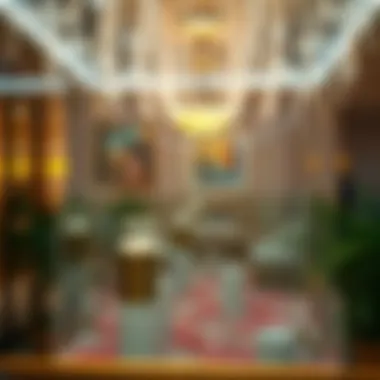

For example, a plexiglass table can combine a clean, modern look while being lightweight and durable. Similarly, plexiglass partitions can create sections in an open space without making it feel cramped. This duality of form and function is essential; form should serve the needs of the space while aligning with the overall design narrative. Designers must continually ask themselves:
- Does this piece fulfill a purpose?
- Is it convenient for daily use?
- Does its shape enhance or detract from its functionality?
By striking the right balance, designers can ensure that their creations not only look good but also serve their intended purposes effectively.
Creating Balance and Harmony
Design isn't merely about individual components; it’s about how they blend together to create a cohesive whole. When incorporating plexiglass, creating balance is critical. This involves not just the physical weight of materials but also visual weight. The transparent nature of plexiglass can make heavier elements feel lighter, thus the interplay is key in achieving harmony.
For instance, using plexiglass alongside wood or metal can help blend sharp contrasts and create an inviting space. Designers should also consider scale; oversized plexiglass pieces might overpower a tiny room, just as too many small elements can look cluttered. A thoughtful arrangement of size and placement fosters a sense of compositional unity.
"True beauty lies in balance—achieving it is the essence of good design."
Creating harmony doesn’t stop with size and materials. The rhythm within the space should lead the eye naturally through the area. Repeating certain elements, such as shapes or colors, can help guide visual navigation, making the space not just beautifully decorated, but also easy to experience.
With these principles firmly established, designers can boldly harness the charm of plexiglass to elevate their spaces, merging style with substance.
Sustainability and Plexiglass
In today’s world, where the environment takes center stage, it’s essential to consider how materials contribute to sustainability. Plexiglass, often lauded for its artistic flexibility and aesthetic charm, does bring with it a conversation about its environmental impact. As decorators and designers embrace this versatile material, understanding its sustainability factors becomes paramount. This section will cover how plexiglass aligns with eco-friendly initiatives and why it is increasingly favored in modern decor.
Eco-Friendly Production
Plexiglass, or acrylic, is manufactured using processes that can be adjusted to lessen environmental burdens. Many manufacturers now prioritize sustainable practices in their production cycles. For example, companies work on minimizing energy consumption during the production phase, opting for renewable energy sources and optimizing manufacturing techniques. Moreover, the raw materials used to create plexiglass are often derived from naturally occurring elements, leading designers to find peace of mind in their selections.
Furthermore, certain brands focus on using recycled materials in their formulations. This approach not only lessens the need for new resources but also effectively reduces waste in landfills. This means that your dazzling plexiglass decor could very well come from post-consumer materials, making every piece not just a statement of style but also a testament to sustainability.
"The shift towards eco-friendly production methods signifies a major step in reducing the carbon footprint of the materials we cherish."
Reusability of Plexiglass in Decor
Plexiglass shines (no pun intended) when it comes to its reusability in decoration. Unlike many materials that have a one-and-done application, plexiglass offers widespread potential for repurposing. Its robust nature allows for easy customization; it can be cut, shaped, or molded to fit new styles and spaces. This adaptability means that pieces can be reused or refashioned to suit changing tastes or trends within a household or business.
Not only can old decor take on a fresh appearance, but the ease of maintenance also enhances its allure. Simple cleaning methods ensure the material retains its luster without the need for harsh chemicals. As an added bonus, when pieces reach the end of their decor life, they can often be recycled, redirecting them away from waste and back into the production cycle.
In summary, considering both the methods of plexiglass production and its remarkable reusability empowers designers and consumers alike to appreciate the eco-friendly aspects of this material. Its role in sustainable decoration is not just a trend; it reflects a responsible choice that honors both style and the planet.
Contemporary Trends in Plexiglass Decoration
The evolution of plexiglass decoration in recent times reflects broader trends across design disciplines. It's important to note how artists, interior designers, and architects are increasingly drawn to plexiglass due to its unique ability to transform spaces without overwhelming them. With sustainability becoming a pillar of contemporary design, the lightweight and versatile nature of plexiglass aligns well with eco-conscious aesthetics. Moreover, its vast range of applications transcends mere functionality; it has become a vehicle for expression, giving rise to contemporary trends that are as diverse as they are innovative.
Minimalism and Transparency
Minimalism is not just a style; it’s a philosophy. It encourages stripping away the unnecessary, an approach that suits plexiglass perfectly. The transparency of plexiglass allows for seamless integration into a variety of environments, rendering it nearly invisible while still providing structure and beauty. For example, a room adorned with clear plexiglass shelving imparts an airy feel, making spaces appear larger and more inviting. This effect is increasingly sought after in urban settings where real estate is tight and maximizing the visual space is crucial.
When it comes to color, less is often more. Minimalist designs favor a clean palette, with transparent or frosted plexiglass often serving as a subtle background that doesn’t compete with bold artwork or furnishings. The essence of this trend is that it’s not about what’s added, but rather what’s made more prominent through the judicious use of space and light. Designers in this trend often employ large sheets of clear plexiglass for partitions, allowing light to filter dramatically through, embracing open-plan styles while creating defined zones in a way that feels effortless.
Bold Statements and Artistic Interpretations
Contrasting the minimalist approach, bold statements with plexiglass echo a different narrative. Here, the material becomes a canvas for artistic expression. Whether it's sculptural pieces or vivid colored installations, the striking visual impact of plexiglass is hard to ignore. For instance, an oversized vibrant plexiglass installation in an office lobby not only serves as a conversation starter but also sets the tone for innovation and creativity within that environment.
Likewise, artists and designers are experimenting with neon hues and intricate shapes, challenging conventional decor boundaries. The layering of plexiglass in multiple dimensions helps create mesmerizing light play, generating depth and interest that can capture anyone's attention. In this vein, one can leverage plexiglass in creating statement lighting fixtures that double as art pieces, drawing the eye while breaking standard design molds.
"Plexiglass allows for playing with light and form in ways that no other material can match. It's about daring to be different."
This new artistry ultimately encourages designers to think beyond traditional decor. Such installations provide opportunities to convey messages or themes through color and structure, making interiors not just visually appealing but also reflective of the values or identity of a space.
In summary, contemporary trends in plexiglass decoration show a dynamic interplay between minimalism and bold artistic interpretations. Each approach offers distinct ways to create environments that resonate with functionality and aesthetic appeal, tailored to modern sensibilities. With these trends, the future of interior design is not just about occupying space but transforming it into meaningful experiences.
Incorporating Plexiglass into Existing Decor
In the realm of interior design, plexiglass offers a unique opportunity to bridge the old with the new. The beauty of incorporating plexiglass into existing decor lies in its versatility. By cleverly integrating this material, one can breathe new life into a space. Whether it's through custom projects or expert tips, the goal centers around enhancing one’s environment while maintaining a degree of elegance and sophistication.
DIY Ideas and Projects
Custom Frames
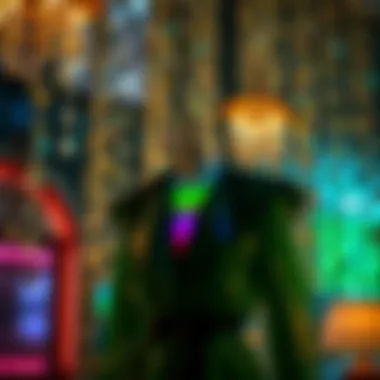

Custom frames crafted from plexiglass are more than mere holders for artwork; they serve as intricate statements of style. One major aspect of using plexiglass in framing is its ability to minimize visual clutter while showcasing cherished pieces. The crystal-clear quality of plexiglass helps art stand out without overshadowing it, making it an increasingly popular choice among designers.
-Benefits of Custom Frames
The lightweight nature of plexiglass frames allows for easy handling and installation. Unlike traditional wooden frames that may succumb to warping over time, plexiglass can withstand varying environmental conditions, thereby ensuring longevity. However, while it's scratch-resistant, it's crucial to handle it with care—as scratches can detract from its otherwise pristine look.
Accent Pieces
Accent pieces made of plexiglass can serve as focal points or subtle compliments to an overarching design theme. These items often exhibit a streamlined aesthetic that brings a touch of modernity into more traditional spaces. One key characteristic of plexiglass accent pieces is that they play well with various color palettes, whether it be bold hues or muted tones.
-Highlighting Advantageous Features
The translucent quality of many plexiglass accents allows them to diffuse light beautifully, creating a warm atmosphere without dominating the room. A slight downside lies in upkeep; dust and fingerprints can be more visible than on other materials, necessitating a regular maintenance schedule.
Expert Tips for Seamless Integration
To integrate plexiglass effortlessly into existing decor, consider a few expert tips:
- Evaluate the Environment: Begin by analyzing the color schemes and textures already present in your space. This allows for a harmonious blend rather than an abrupt contrast.
- Mixed Materials: Use a combination of materials—like metal or wood with plexiglass—to create depth and interest in your design.
- Use Lighting Strategically: Position lighting to highlight plexiglass elements, making them shine while casting interesting shadows that enhance visual appeal.
In summary, successful integration of plexiglass elements requires thoughtful consideration about existing decor and the intended atmosphere of the space. By implementing these strategies, one can achieve a refined look while enjoying the myriad benefits that plexiglass has on offer.
Challenges of Using Plexiglass
While plexiglass is a favored choice for its aesthetic appeal and versatility, it doesn't come without its set of challenges. Understanding these hurdles is essential for anyone looking to incorporate this material into their decorative schemes. Here, we break down vital considerations that can greatly affect both the practical use and aesthetic outcome of your plexiglass installations.
Maintenance and Care
Plexiglass requires a bit of attention when it comes to maintenance. Unlike traditional glass, which can withstand harsh abrasives, plexiglass is susceptible to scratches and may lose its luster over time if not properly maintained. Regular cleaning with a soft cloth and a gentle cleanser is essential to keep it looking pristine.
Tips for Maintenance:
- Avoid Ammonia-Based Cleaners: These cleaners can lead to cloudy surfaces. Instead, opt for a mild soap and water solution.
- Gentle Wiping: Use microfiber cloths to prevent scratching.
- Sunlight Considerations: Extended exposure to direct sunlight can cause fading. Installing in shaded areas could help prolong the appearance.
Keeping these considerations in mind can help preserve both the longevity and the beauty of plexiglass decor.
Cost Considerations
When integrating plexiglass into decorative projects, budgeting must be a critical aspect of your planning. Plexiglass is often more costly than traditional materials, like wood or regular glass. However, its durability can sometimes justify the higher price tag.
Factors Affecting Cost:
- Thickness and Quality: Thicker, high-quality plexiglass tends to be more expensive but offers better durability and clarity.
- Customization: Custom cuts or designs will increase the cost. We're talking about paying for the artistry and precision that goes into these tailored pieces.
- Installation Expenses: Depending on the complexity of the project, hiring professionals to ensure a proper installation can add to the overall budget.
Ultimately, understanding these costs can help you make informed decisions, allowing you to allocate resources effectively without compromising on aesthetics.
Future of Plexiglass in Decoration
As we stand at the intersection of material innovation and design evolution, the future of plexiglass in decoration emerges as a topic of pivotal significance. This lightweight and durable medium not only enhances aesthetic appeal but also offers practical solutions in varied decor contexts. The advances in technological applications and the inherent characteristics of plexiglass present opportunities for designers to reimagine spaces in fresh and functional ways.
One of the core benefits of integrating plexiglass into future designs is its versatility. Unlike traditional materials, plexiglass can be molded and shaped into myriad forms, allowing designers to push the boundaries of creativity. For instance, we could see new sculptural pieces that don’t just serve a decorative role but transform into functional art. With advancements in 3D printing technology, producing unique plexiglass items tailored for individual spaces becomes less of a dream and more of a reality. This invites a new era of personalization in interior decor, where each piece tells a story and fits the unique needs of the user.
"In the age of customization, designs that speak uniquely to individuals will take center stage. Plexiglass is at the forefront of this revolution."
Innovations in Design and Usage
Emerging innovations are set to redefine how plexiglass is utilized within interior design. One noteworthy development is the creation of interactive designs that engage users in a multi-sensory way. For instance, incorporating LED technology embedded within plexiglass can result in spectacular lighting installations that do more than illuminate a space; they create atmospheres that change mood with the flick of a switch. Think sculptures that glow or panels that shift color—these innovations don’t merely fill space; they command attention and evoke emotion.
Furthermore, the potential for plexiglass to be utilized in sustainable design is rapidly increasing. New eco-friendly production methods are being developed that lower the carbon footprint of plexiglass manufacturing. Designers now have the opportunity to use recycled plexiglass or materials sourced from sustainable practices, enabling a greener approach without sacrificing aesthetics. This not only supports environmental goals but aligns with the values of a growing conscientious consumer base.
Predicted Trends
As we gaze into the crystal ball of design, several trends are anticipated to take root within the realm of plexiglass decoration. First and foremost is the surge of biophilic design. As urban spaces continue to grow and nature becomes more distant, incorporating plexiglass features that mimic natural forms can bridge that gap. Expect to see designs that evoke organic shapes, such as flowing curves and leaf-like structures, that can bring a semblance of the outside world indoors, captivating the senses.
Additionally, the minimalist mindset that has gained momentum over the past years will likely continue to thrive with plexiglass's transparent qualities. Minimalist decor, stripped of excess, finds harmony in clear lines and simplicity, allowing for unobstructed views and a sense of openness. Designers are likely to create streamlined furniture that serves essential functions while promoting an airy feel within compact living spaces.
Closure
In the context of plexiglass decoration, the conclusion isn't merely a wrap-up; it serves as a reflection of all discussed elements and their implications for both designers and everyday users. The overarching theme highlights the blend of functionality and aesthetic appeal that plexiglass brings to modern interiors and displays.
First and foremost, it's important to recognize that plexiglass is not just a material—it's a canvas for creativity. Its versatility allows for a range of applications, from the sleek, minimalistic lines of furniture to more audacious sculptures and wall art. This adaptability makes plexiglass a favorable choice for various design philosophies, whether one leans towards contemporary understated elegance or bold artistic statements.
The benefits of utilizing plexiglass extend beyond mere appearance. Its lightweight nature allows for easy handling and installation, making it accessible for both seasoned designers and DIY enthusiasts. Maintenance is another consideration, as proper care ensures that the pieces maintain their clarity and brilliance. For someone looking to enhance their space without overwhelming it, plexiglass can often fit the bill perfectly.
When considering sustainability, the article has pointed out that advancements in eco-friendly production methods are increasingly prevalent. As consumers become more conscientious about their choices, integrating plexiglass into sustainable design strategies resonates well with modern sensibilities. The material's reusability opens pathways for evolving trends and transforming spaces without incurring a significant environmental footprint.
As for future implications, innovations in design suggest that plexiglass will remain a relevant player in the decoration industry. With its potential to shape environments in unique ways, it allows designers and consumers alike to push boundaries while embracing evolving trends. The anticipated fusion of digital technology and traditional design elements could lead to exciting new uses for plexiglass.
In wrapping up, understanding how to leverage plexiglass effectively can empower individual expression in decorating. It encourages a thoughtful approach to design that balances beauty and practicality. For those engaged in the realms of fashion, styling, and retail, keeping an eye on plexiglass trends will undoubtedly yield fruitful opportunities to elevate how spaces are experienced.
